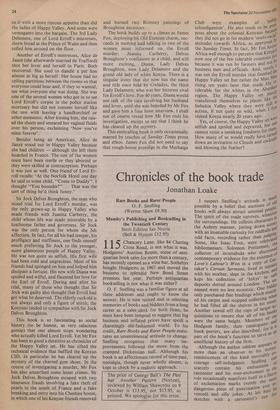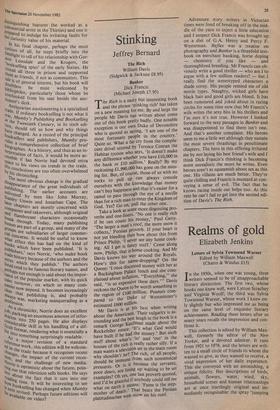Chronicles of the book trade
Jonathan Loake
Rare Books and Rarer People 0. F. Snelling
(Werner Shaw £9.50) Mumby's Publishing and Bookselling in the Twentieth Century Sixth Edition Ian Norrie (Bell & Hyman £12.95)
115 Chancery Lane, like 84 Charing Cross Road, is not what it was. Hodgsons' Auction Room, scene of anti- quarian book sales for more than a century, has recently opened as a wine bar. Sothebys bought Hodgsons in 1967 and moved the business to splendid New Bond Street premises last year. Perhaps antiquarian bookselling is not what it was either?
0. F. Snelling was a familiar figure at all these addresses and ought to know the answer. He is now retired and in selecting memories of books and bidders from a long career as a sales clerk for both firms, he must have been tempted to suggest that big business and inflated prices have spoilt a charmingly old-fashioned world. To his credit, Rare Books and Rarer People main- tains an unsentimental attitude to change. Snelling recognises that many im- provements followed the move from the cramped Dickensian hall. Although his book is an affectionate record of time past, nostalgia, though never wholly absent, is kept in check by a realistic approach.
The price of George Ball's The Past has Another Pattern (Norton), reviewed by William Shawcross on 9 October is £13.95, not $13.95, as printed. We apologise for this error. I suspect Snelling's attitude is inad,Ae possible by a belief that auctions of °I" books will always attract unusual people; The spirit of the trade survives, whate`':' the surroundings. He collects characters in the Aubrey manner, jotting down storieds with an insatiable curiosity for oddballs an odd facts, recording rather than incigl Some, like Isaac Foot, were celebrat bibliomaniacs. Solomon Pottesman, tielej collector of incunabula who discovered contemporary evidence for the existence or" Love's Labour's Won in a copY of Gal,,r taker's Certain Sermons, lived M squaivd with his mother, slept in the kitchen, °fife kept his collection of `Inkys' in safe ,, deposits dotted around London. Tbe:ce;
named were no less eccentric. One biu
n only purchased fine bindings which matte ed his carpet and stopped collecting val he had filled all the shelves in his rooinc: Another sawed off the tops of larger a. quisitions to ensure that all of his boore were the same height. Members of t d Hodgson family, their cataloguers anis book porters, are also described, for it part of the book's function to serve as an
unofficial history of the firm. as
Although the author seldom appears more than an observer in his stories' reminiscences of this kind inevitably can courage self-indulgence. Snelling c scarcely contain his enthusiasm raconteur and his over-excitement in IP., role occasionally manifests itself in a flor_15'5 of exclamation marks (surely the 011.'0, dangerous piece of punctuation even vented) and silly jokes. At his best roi'r sketches with a cartoonist's eye distinguishing features (he worked as a i commercial artist in the Thirties) and one is prepared to indulge his irritating faults for the curiosity value of his material. In his final chapter, perhaps the most curious of all, he steps briefly into the limelight to tell of his relationship with Gor- don Lonsdale and the Krogers, the ..Okselling spies' of the early Sixties. He visited all three in prison and supported them as friends, if not as communists. This ;ale is of general interest, but his book will doubtless be most welcomed by ohhoPhiles, particularly those whom he .verlooked from his seat beside the auc- tioneer's desk. Antiquarian auctioneering is a specialised trade. If ordinary bookselling is not what it wade. Mumby's Publishing and Bookselling In. the Twentieth Century, in its sixth ech- ti:°11, should tell us how and why things ',aye changed. As a record of the principal booksellers and publishers, Mumby pro- vhi.des a comprehensive collection of brief t 1°graPhies. As a history, and thus as an in- erDretation of facts, it would be more ac- cessible if Ian Norrie had devoted extra Hceto his views on trends in the trade. b L IS conclusions are too often overwhelmed Y his chronicling. dl. The most obvious change is the gradual saPPearance of the great individuals of Publishing. The earlier accounts are esnlivened by men like John Murray, la ere Linwin and Jonathan Cape. The er chapters are mostly concerned. with a°111Panies and takeovers, although original bri,c1 flamboyant characters occasionally houses through. Today, many publishing a°1rses are ugh. Today, a group, and many of the je'llr's are subsidiaries of larger commer- wial concerns. It would be useful to know hat effect this has had on the kind of u°0,ks Pub which have been published. 'It is , ushers,' says Norrie, 'who make book s'rad, c history because of the authors and the lien" which they publish.' The authors osted tend to be famous literary names, and t erhaps not enough is said about the impor- s4,1,1ce of the popular market, with its quick 1;1eS turnover, on which so many corn- :nes now depend. It becomes increasingly aiewar that publishing is, and probably P roafeYssions was' marketing masquerading as a jei:c's a chronicler, Norrie does an excellent
packing -.n8 an enormous amount of into 250 pages. He also displays riunsiderable skill in his handling of a clif- lt11.11- format, rendering what is essentially a
tAint° something surprisingly readable. ref„8 a Major revision of a standard 7enee work, this edition will be welcom- e6'" the trade because it recognises recent sit;flges, the impact of the current reces- Non,. and the challenge of new media. tin rile is optimistic about the future, pc:lin- k? out that television sells books. He says read about the fact that it cuts into our ho—'148 time. It will be interesting to see hw hookselling has changed when Mumby be"ext evised. Perhaps future editions will available on Perhaps future











































 Previous page
Previous page